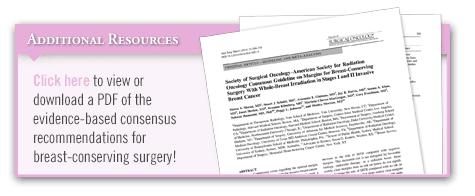Despite recent improvements in imaging technology, pathology assessments, and the use of systemic therapy, there is still controversy regarding the optimal margin width in breast-conserving surgery. About 25% of patients with invasive breast cancer return to the operating room after undergoing lumpectomy to obtain more widely clear margins. In about half of these cases, the margin is free of cancer cells, defined as no ink on tumor. However, it has long been believed that a larger amount of normal breast tissue might reduce the risk of local recurrence.
Recommendations for Breast-Conserving Surgery
In 2014, the Society of Surgical Oncology (SSO) and the American Society of Radiation Oncology (ASTRO) released recommendations for breast-conserving surgery with whole-breast irradiation in stage I and II invasive breast cancer. “A definitive guideline can help minimize the use of unnecessary surgery while maintaining the excellent outcomes that have been achieved with lumpectomy and radiation therapy,” explains Monica M. Morrow, MD, FACS, who co-chaired the consensus panel that developed the recommendations.
To develop the SSO-ASTRO guidelines, leaders in surgical, radiation, and medical oncology as well as pathology and patient advocacy considered a meta-analysis of margin width and ipsilateral breast tumor recurrence (IBTR). The panel conducted a systematic review of 33 studies that included 28,162 patients as the primary evidence base. The panel recommended against the routine removal of larger amounts of healthy breast tissue beyond having no cancerous cells touching the edge of lumpectomy specimens. This recommendation was made regardless of patient age as well as for women with the more aggressive, triple-negative cancer types.
“The standard definition of negative margins should be having no ink on invasive carcinoma or ductal carcinoma in situ,” says Dr. Morrow. “The use of no ink on tumor as the standard for an adequate margin in the era of multidisciplinary therapy has been associated with low rates of IBTR. It also has the potential to decrease re-excision rates, improve cosmetic outcomes, and decrease healthcare costs.”
Enhancing Cancer Outcomes
Dr. Morrow says it is hoped that the SSO-ASTRO recommendations will help improve the lives and treatment of patients touched by this disease. “These recommendations are evidence-based strategies that may help us reduce healthcare costs and improve the course of treatment,” she says. “Ultimately, this guidance may reduce the high re-excision rates that have been seen in women with early-stage disease who undergo breast-conserving surgery. Many re-excisions are unnecessary because disease control is often excellent for women with early-stage breast cancer when radiation therapy, hormone therapy, and/or chemotherapy are added to their treatment plan.”




 TimH
TimH